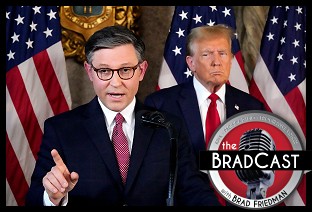 Late last week, the California state Senate adopted a proposal for a state-run, single-payer, "Medicare for All" style healthcare system. That's just the latest encouraging news to suggest that, on the surface, single-payer healthcare advocates have the wind at their sails in the Golden State.
Late last week, the California state Senate adopted a proposal for a state-run, single-payer, "Medicare for All" style healthcare system. That's just the latest encouraging news to suggest that, on the surface, single-payer healthcare advocates have the wind at their sails in the Golden State.
Buoyed by a public opinion poll that showed that 70% of Californians support SB-562 ("The Health California Act") --- the state Senate measure that aspires to provide publicly-funded quality healthcare to all California residents --- and a newly released Political Economy Research Institute (PERI) Study, which concluded that the measure would save California $37.5 billion in annual healthcare expenditures while covering millions of additional residents, single-payer advocates have encountered smooth sailing in the California State Senate. Last Thursday, that legislative body approved the bill by a 23-14 vote with three members not voting.
The measure now moves to the state Assembly, and irrespective of whether it is similarly approved there, the good ship Single-Payer is about to encounter choppy waters and a stiff headwind.
SB-562's authors, Senators Ricardo Lara (D-Baldwin Park) and Toni Atkins (D-San Diego), deferred questions about the new taxes needed to fully fund their proposed, state-run single-payer healthcare system. A separate tax measure would have to be approved by a 2/3 vote in both Houses of the California legislature. Democrats hold super majorities in each chamber. However, 2/3 passage is by no means a given.
The landmark single-payer initiative and tax measure to fund it would then have to be signed into law by Democratic Gov. Jerry "Budget Miser" Brown, who has already expressed concerns about how a single-payer system could be financed.
Moreover, as evidenced in recent days, the otherwise popular measure also faces a hostile corporate-owned media...
Bad Press
On June 1, Los Angeles Times reporter Patrick McGreevy, who failed to mention the PERI study, cited the questionable claim made by Office of the California Legislative Analyst (CLA) that, contrary to the PERI study, SB-562 would "increase" the state's annual healthcare expenditures from $368.5 billion to "$400 billion per year, at full enrollment."
That figure has been repeatedly cited by the media, Republicans and even some Democrats as if it were an established fact.
In a lengthy June 1 article L.A. Times reporter Melanie Mason sets forth the cost differential between the CLA and PERI studies ($400 billion vs. $331 billion), but fails to note that the cost projection under the PERI study is $37.5 billion "less" than the $368.5 billion Californians now pay for an inefficient, multi-payer system that leaves 2.7 million uninsured and another 12 million underinsured.
Prior to publication of the PERI study, Los Angeles Times columnist George Skelton cited the CLA's $400 billion cost estimate in an article which sought to summarily dismiss the very idea of a state-run, single-payer healthcare program as an unattainable pipe-dream. In a subsequent hit piece, Skelton sought to undercut the idea of providing quality care to all residents by noting that the bill would cover "roughly 2 million who migrated here illegally."
Skelton neglects to mention that those undocumented immigrants pay approximately $3.2 billion per year in federal, state and local taxes.
Skelton then falsely proclaims: "No one even knows the bill's price."
The Times columnist eventually gets around to mentioning the PERI study, but only in the context of questioning its reliability. He points out that the study, which had been performed by a group of economists from the University of Massachusetts-Amherst ("UMA"), had been solicited by a single-payer advocacy group, the California Nurse's Association.
In addition to its cost analysis, the PERI study addresses, but does eliminate, valid concerns about the projected sources of financing. Nevertheless, single-payer advocates can point to the PERI study and a multitude of data to demonstrate The Healthy California Act's advisability as well as its feasibility.
Why single-payer?
Like the rest of the United States, California operates a government-subsidized, profit-driven, market-based healthcare system that essentially treats healthcare as a commodity. Single-payer advocates, like Sen. Bernie Sanders (I-VT), regard healthcare as a fundamental right which must be guaranteed to everyone, irrespective of economic status.
The U.S. healthcare system is extraordinarily expensive, yet remarkably inefficient.
The U.S. spends nearly two and one-half times more per capita for healthcare than the average per capita healthcare expenditures amongst the 34 single-payer nation-members of the Organization for Economic Co-operation and Development (OCED). For example, U.S. per capita expenditures in 2013 ($8,713) nearly tripled the per capita expenditures in Britain (U.K.) ($3,235).
According to a 2014 Commonwealth Fund study, however, the U.S. healthcare delivery system ranked dead last amongst eleven industrial nations in terms of "quality, efficiency, access to care, and healthy lives." Indeed, citing its own Health-Care Efficiency Index, Bloomberg reported last year that the U.S. healthcare system is one of the world’s "least-efficient," ranking 50th out of the 55 countries measured in 2014. The Commonwealth Fund study ranked the U.K., which offers not only single-payer but a fully government-run healthcare system, as number one.
It isn't just that we pay much more for less. Our profit-before-people healthcare system, even under the Affordable Care Act (ACA, or "Obamacare"), often imposes harsh economic tolls on those who have to choose between food and the cost of medicine, or those who are forced into bankruptcy as a result of unpaid medical bills.
"Nobody [in the U.S.] dies because they don't have access to healthcare", Idaho's Republican Congressman Raúl Labrador recently argued, to much deserved scorn, at a town hall with constituents last month.
It was an absurd comment on its face, but the truth is, nobody dies for lack of access to healthcare coverage in single-payer countries. In the U.S., according to a 2009 pre-Obamacare Harvard Medical Study, 45,000 Americans die each year for lack of coverage --- numbers that were no doubt proportionately reduced but not eliminated by the Affordable Care Act. The ACA reduced the number of uninsured Americans from 47 million to 27 million.
Here, in California, according to the PERI study, public funding accounts for 71% of California's $368.5 billion annual healthcare expenditures. Much of that money goes not to pay for healthcare but to enhance the bottom line of the private, for-profit health insurance cartel, which is enjoying "record profits," according to Amy Martyn at Consumer Affairs late last year. Nonetheless, at present, some 2.7 million California residents are uninsured and another 12 million are "underinsured", according to the PERI study.
CLA's likely erroneous cost projection
In reply to an email inquiry from The BRAD BLOG, UMA Economics Professor Gerald Friedman described the CLA's estimate that the proposed California single-payer system would "increase" the annual cost of healthcare in California from approximately $367 billion to $400 billion as "conservative if not ridiculous."
"They underestimate administrative savings (both among providers and for insurance) and they discount the system's ability to negotiate prices for drugs, medical equipment, and provider services (hospitals)," Prof. Friedman wrote. "They also overstate the cost of the program including the effect on utilization of removing copays and deductibles."
That appears to be a valid critique. The CLA begins its assessment by pointing to what it says is an "enormous uncertainty" because SB-562 would entail an "unprecedented" rebuilding from a multi-payer to a single-payer healthcare system. Based upon its assertion that 8% of California residents are now uninsured, the CLA's estimated increase appears very close to the extrapolated costs of current expenditures (1.08 x $367 billion/yr. = $396.36 billion/yr.). This is not all that far off from the PERI analysis. The UMA economists, using a $368.5 billion cost figure, calculated that if, sans single-payer cost controls, one were to simply expand full coverage under the "existing [multi-payer] system," to cover all Californians, this "would increase overall costs...to $404.1 billion."
On its face, the CLA analysis reflects the type of glaring underestimate of administrative savings cited by Friedman. The CLA argues administrative costs under the current multi-provider system is 7% of total healthcare costs. A study performed before passage of the Affordable Care Act by a non-profit physicians group supporting a single-payer system found that 31%, not 7%, of U.S. healthcare dollars were spent on administration of our private insurance system. "Streamlined to Canadian levels," Physicians for a National Health Program argued, "enough administrative waste could be saved to provide comprehensive insurance to all Americans."
SB-562 would eliminate all liability to residents for insurance premiums, co-pays and deductibles. It would provide for "universal" coverage under the aegis of a single, state-run entity, the Healthy California Board (HCB). The HCB would be empowered to regulate fees, standards and the coordination of all medical and hospital services. The HCB would also be empowered to collectively negotiate the price for pharmaceuticals.
It is these significant cost controls that form the basis for the PERI study's conclusion that all but the wealthiest Californians will pay a great deal less for healthcare under a new California single-payer system than they do now.
Comparative studies
There are multiple studies that project significant cost savings via the adoption of a single-payer healthcare system. These include a 2005 Lewin Group economic analysis which estimated that passage of a previous California single-payer bill would have saved the state $344 billion over ten years.
In a 2013 study, Prof. Friedman estimated that a federal single-payer healthcare system would save $1.8 trillion per decade while benefiting 95% of U.S. households. "The U.S.," Friedman concluded, "could save an estimated $592 billion annually by slashing the administrative waste associated with the private insurance industry ($476 billion) and reducing pharmaceutical prices to European levels ($116 billion)."
In a recent analysis, Friedman concluded that a New York state single-payer bill would reduce costs for 98% of citizens in the Empire State and "save over $70 billion by eliminating health insurance company administration and profit."
Precarious financial pillar
The PERI study notes that, under the existing system, public funding, including Medicare and MediCal, account for 71% of California's $368.5 billion annual healthcare expenditures. Under SB-562, the state would seek waivers from the federal government, so that federal monies would be received by the state agency assigned to administer its state-run single-payer system. "These funds," according to the new study, "will provide $225 billion [per year] in funding for the state's single-payer program."
While that could be an ideal source of funding, it is a proposal that is fraught with uncertainty. First, there is no guarantee that the hostile Trump Administration would grant such waivers. Second, even if the waivers could be secured, there is a risk --- albeit politically slight --- that Congress would approve and the President sign into law the draconian American Health Care Act (ACHA) which would gut Medicaid, thereby eliminating a major source of the funding needed to operate California's proposed single-payer system.
Of course, if the AHCA were passed, it would drastically increase the numbers who are uninsured or underinsured. For those in need, healthcare coverage will become unaffordable. In the event of passage of the Trump/Ryan "wealth care" bill, the need to come up with a progressive tax plan for a state-run system that could prevent a humanitarian catastrophe would be greatly enhanced.
If one were to assume that the AHCA fails and that California could secure the necessary federal waivers, under SB-562 the state would still have to raise an additional $106 billion per year to fully fund the new single-payer system. The authors of the PERI study suggest the needed funds could come from two new taxes: a 2.3% gross receipts tax on businesses (with an exemption on the first $2 million in income, to help small business) and a statewide 2.3% sales tax. Both new taxes involve some exemptions and tax credits for small businesses and low income families.
Securing $106 billion a year from those tax sources is not really a stretch. Those 2.3% gross receipts and sales taxes would be applied in a Golden State, whose $2.46 trillion GDP makes it the world's 6th largest economy. And, remember, under a single-payer healthcare system, most residents would save money, since they would no longer be paying premiums, deductibles or co-pays. But the authors of SB-562 should perhaps consider an increase on the taxes imposed on high income earners to offset a portion of the sales tax, which is otherwise a regressive form of taxation.
Conclusion
The California State Senate's approval of SB-562 may have provided sweet music for single-payer advocates, but there are numerous obstacles that must be overcome before a state-run universal healthcare system becomes a reality. Nonetheless, following last week's vote, California is, at least, one step closer.


 Sunday 'Total Obliteration' Toons
Sunday 'Total Obliteration' Toons Thank You For Your Attention to This Matter:
Thank You For Your Attention to This Matter: 'Green News Report' 6/26/25
'Green News Report' 6/26/25
 Mamdani Primary 'Win' Augurs New Generation of Progressives Rising: 'BradCast' 6/25/25
Mamdani Primary 'Win' Augurs New Generation of Progressives Rising: 'BradCast' 6/25/25 U.S. Authoritarianism Under-way (But We're Still Here to Fight It): 'BradCast' 6/24/25
U.S. Authoritarianism Under-way (But We're Still Here to Fight It): 'BradCast' 6/24/25 'Green News Report' 6/24/25
'Green News Report' 6/24/25 'Anti-War' Trump Attacks a Mid-East Nation on False Claims About WMD: 'BradCast' 6/23/25
'Anti-War' Trump Attacks a Mid-East Nation on False Claims About WMD: 'BradCast' 6/23/25  Sunday 'Peacemaker' Toons
Sunday 'Peacemaker' Toons Senate Health Care Cuts 'More Extreme' Than House Version: 'BradCast' 6/19/25
Senate Health Care Cuts 'More Extreme' Than House Version: 'BradCast' 6/19/25 'Green News Report' 6/19/25
'Green News Report' 6/19/25 What 'Anti-War President'? MAGA Civil War Over Trump, Iran: 'BradCast' 6/18/25
What 'Anti-War President'? MAGA Civil War Over Trump, Iran: 'BradCast' 6/18/25 Trump Calls for 'Remigration', a Codeword for 'Ethnic Cleansing': 'BradCast' 6/17/25
Trump Calls for 'Remigration', a Codeword for 'Ethnic Cleansing': 'BradCast' 6/17/25 'Green News Report' 6/17/25
'Green News Report' 6/17/25 Last Weekend Today: 'BradCast' 6/16/25
Last Weekend Today: 'BradCast' 6/16/25 Sunday 'Despot Times, Despot Measures' Toons
Sunday 'Despot Times, Despot Measures' Toons Then They Came for the U.S. Senators: 'BradCast' 6/12/25
Then They Came for the U.S. Senators: 'BradCast' 6/12/25 'Green News Report' 6/12/25
'Green News Report' 6/12/25 Lawless Trump Warms Up for Insurrection Act: 'BradCast' 6/11/25
Lawless Trump Warms Up for Insurrection Act: 'BradCast' 6/11/25 Trump Inciting Violence, State of Fear in L.A., Elsewhere: 'BradCast' 6/10/25
Trump Inciting Violence, State of Fear in L.A., Elsewhere: 'BradCast' 6/10/25 Nevermind Elon and Epstein Files, Trump Declares L.A. 'Riots'!: 'BradCast' 6/9/25
Nevermind Elon and Epstein Files, Trump Declares L.A. 'Riots'!: 'BradCast' 6/9/25 'Jesus Weeps' at Trump's
'Jesus Weeps' at Trump's 300k 'Preventable' Deaths Since Trump USAID Shutdown: 'BradCast' 6/4/25
300k 'Preventable' Deaths Since Trump USAID Shutdown: 'BradCast' 6/4/25 Storm Warnings: 'BradCast' 6/3/25
Storm Warnings: 'BradCast' 6/3/25 SCOTUS Ignores Own Precedents In Recent 'Emergency' Rulings: 'BradCast' 6/2/25
SCOTUS Ignores Own Precedents In Recent 'Emergency' Rulings: 'BradCast' 6/2/25 'A World of Tyrants, Bribes, and Influence': 'BradCast' 5/22/25
'A World of Tyrants, Bribes, and Influence': 'BradCast' 5/22/25
 VA GOP VOTER REG FRAUDSTER OFF HOOK
VA GOP VOTER REG FRAUDSTER OFF HOOK Criminal GOP Voter Registration Fraud Probe Expanding in VA
Criminal GOP Voter Registration Fraud Probe Expanding in VA DOJ PROBE SOUGHT AFTER VA ARREST
DOJ PROBE SOUGHT AFTER VA ARREST Arrest in VA: GOP Voter Reg Scandal Widens
Arrest in VA: GOP Voter Reg Scandal Widens ALL TOGETHER: ROVE, SPROUL, KOCHS, RNC
ALL TOGETHER: ROVE, SPROUL, KOCHS, RNC LATimes: RNC's 'Fired' Sproul Working for Repubs in 'as Many as 30 States'
LATimes: RNC's 'Fired' Sproul Working for Repubs in 'as Many as 30 States' 'Fired' Sproul Group 'Cloned', Still Working for Republicans in At Least 10 States
'Fired' Sproul Group 'Cloned', Still Working for Republicans in At Least 10 States FINALLY: FOX ON GOP REG FRAUD SCANDAL
FINALLY: FOX ON GOP REG FRAUD SCANDAL COLORADO FOLLOWS FLORIDA WITH GOP CRIMINAL INVESTIGATION
COLORADO FOLLOWS FLORIDA WITH GOP CRIMINAL INVESTIGATION CRIMINAL PROBE LAUNCHED INTO GOP VOTER REGISTRATION FRAUD SCANDAL IN FL
CRIMINAL PROBE LAUNCHED INTO GOP VOTER REGISTRATION FRAUD SCANDAL IN FL Brad Breaks PA Photo ID & GOP Registration Fraud Scandal News on Hartmann TV
Brad Breaks PA Photo ID & GOP Registration Fraud Scandal News on Hartmann TV  CAUGHT ON TAPE: COORDINATED NATIONWIDE GOP VOTER REG SCAM
CAUGHT ON TAPE: COORDINATED NATIONWIDE GOP VOTER REG SCAM CRIMINAL ELECTION FRAUD COMPLAINT FILED AGAINST GOP 'FRAUD' FIRM
CRIMINAL ELECTION FRAUD COMPLAINT FILED AGAINST GOP 'FRAUD' FIRM RICK SCOTT GETS ROLLED IN GOP REGISTRATION FRAUD SCANDAL
RICK SCOTT GETS ROLLED IN GOP REGISTRATION FRAUD SCANDAL VIDEO: Brad Breaks GOP Reg Fraud Scandal on Hartmann TV
VIDEO: Brad Breaks GOP Reg Fraud Scandal on Hartmann TV RNC FIRES NATIONAL VOTER REGISTRATION FIRM FOR FRAUD
RNC FIRES NATIONAL VOTER REGISTRATION FIRM FOR FRAUD EXCLUSIVE: Intvw w/ FL Official Who First Discovered GOP Reg Fraud
EXCLUSIVE: Intvw w/ FL Official Who First Discovered GOP Reg Fraud GOP REGISTRATION FRAUD FOUND IN FL
GOP REGISTRATION FRAUD FOUND IN FL

































